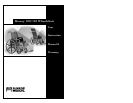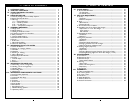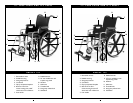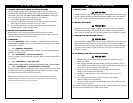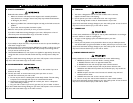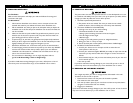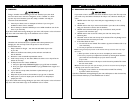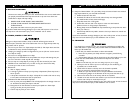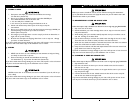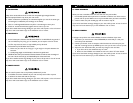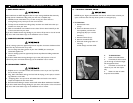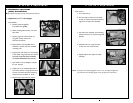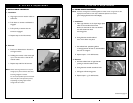
17
VI. WARNINGS: FALLS & TIP-OVERS
▲
!
9. Ramps At Home & Work - For your safety, ramps at home and work must meet all
legal requirements for your area.We recommend:
a. Width.At least four feet wide.
b. Guardrails.To reduce the risk of a fall, sides of ramp must have guardrails
(or raised borders at least three inches high).
c. Slope. Not more than a 10% grade.
d. Surface. Flat and even, with a thin carpet or other non-skid material.
(Make sure there is no lip, bump or depression.)
e. Bracing. Ramp must be STURDY.You may need bracing so ramp does not “bow”
when you ride on it.
f. Avoid A Drop Off.You may need a section at the top or bottom to smooth out
the transition.
If you fail to heed these warnings damage to your chair, a fall, tip-over or loss of control
may occur and cause severe injury to the wheelchair user or others.
H. TRANSFER
It is dangerous to transfer on your own. It requires good balance and agility. Be
aware that there is a point during every transfer when the wheelchair seat is not
below you.To Avoid A Fall:
1. Work with your health care advisor to learn safe methods.
a. Learn how to position your body and how to support yourself during
a transfer.
b. Have someone help you until you know how to do a safe transfer on your own.
2. Lock the rear wheels before you transfer.This keeps the rear wheels
from rolling.
Note: This will NOT keep your chair from sliding away from you or tipping.
3. Move your chair as close as you can to the seat you are transferring to.
If possible, use a transfer board.
4. Rotate the front casters until they are as far forward as possible.
5. If you can, remove or swing footrests out of the way.
a. Make sure your feet do not catch in the space between the footrests.
b. Avoid putting weight on the footrests as this may cause the chair to tip.
6. Make sure armrests are out of the way and do not interfere.
7. Transfer as far back onto the seat surface as you can.This will reduce the risk
that the chair will tip or move away from you.
If you fail to heed these warnings damage to your chair, a fall, tip-over or loss of control
may occur and cause severe injury to the wheelchair user or others.
16
VI. WARNINGS: FALLS & TIP-OVERS
▲
!
F. MOVING BACKWARD
Use extra care when you move your chair backward.Your chair is most stable when
you propel yourself forward.You may lose control or tip over if one of the rear
wheels hits an object and stops rolling.
1. PROPEL YOUR CHAIR SLOWLY AND SMOOTHLY.
2. IF YOUR CHAIR HAS ANTI-TIP TUBES, MAKE SURE TO LOCK
THEM IN PLACE.
3. Stop often and check to be sure your path is clear.
If you fail to heed these warnings damage to your chair, a fall, tip-over or loss of con-
trol may occur and cause severe injury to the wheelchair user or others.
G. RAMPS, SLOPES & SIDE HILLS
Riding on a slope, which includes a ramp or side hill, will change the center of
balance of your chair.Your chair is less stable when it is at an angle.Anti-tip tubes may
not prevent a fall or tip-over.
1. Do not use your chair on a slope steeper than 10%. (A 10% slope means: one foot
in elevation for every ten feet of slope length.)
2. Always go as straight up and as straight down as you can. (Do not “cut the corner”
on a slope or ramp.)
3. Do not turn or change direction on a slope.
4. Always stay in the CENTER of the ramp. Make sure ramp is wide enough that you
are not at risk that a wheel may fall over the edge.
5. Do not stop on a steep slope. If you stop, you may lose control of your chair.
6. NEVER use rear wheel locks to try to slow or stop your chair.This is likely
to cause your chair to veer out of control.
7. Beware Of:
a. Wet or slippery surfaces.
b. A change in grade on a slope (or a lip, bump or depression).These may cause a
fall or tip-over.
c. A drop-off at the bottom of a slope. A drop-off of as small as 3/4 inch can stop
a front caster and cause the chair to tip forward.
8. To Reduce The Risk Of A Fall Or Tip-Over:
a. Lean or press your body UPHILL.This will help adjust for the change in the cen-
ter of balance caused by the slope or side hill.
b. Keep pressure on the handrims to control your speed on a down slope.
If you go too fast you may lose control.
c. Ask for help any time you are in doubt.



